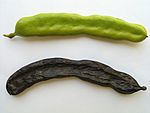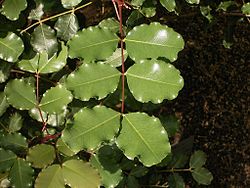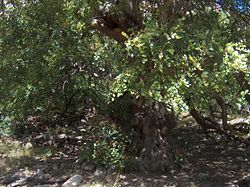- Ceratonia siliqua
-
Ceratonia siliqua 
Illustration of the Carob tree's vegetative components (Ceratonia siliqua). Scientific classification Kingdom: Plantae (unranked): Angiosperms (unranked): Eudicots (unranked): Rosids Order: Fabales Family: Fabaceae Genus: Ceratonia Species: C. siliqua Binomial name Ceratonia siliqua
L. Ceratonia siliqua in native habitat.
Ceratonia siliqua in native habitat.
Ceratonia siliqua, commonly known as the Carob tree and St John's-bread,[1] is a species of flowering evergreen shrub or tree in the pea family, Fabaceae. It is widely cultivated for its edible legume beans, and as an ornamental tree in gardens.
It is native to: the Mediterranean region including Southern Europe, Northern Africa, the larger Mediterranean islands; to the Levant and Middle-East of Western Asia into Iran; and to the Canary Islands and Macaronesia.[2][3]
The vernacular names in other cultures and languages for Ceratonia siliqua include: Arabic: خروب, kharrub kharrūb; German: Johannisbrotbaum; Greek: χαρουπιά, haroupia or Greek: ξυλοκερατιά, ksylokeratia ; Spanish: algarrobo, caroba; French: caroubier, caroube; Hebrew: חרוב ḥaruv; Portuguese: alfarrobeira; Catalan: garrofa; Sicilian: carrubba; Turkish: keçiboynuzu; Croatian: rogač.[2]
Contents
Morphology
The Ceratonia siliqua tree grows up to 10 metres (33 ft) tall. The crown is broad and semi-spherical, supported by a thick trunk with brown rough bark and sturdy branches. Leaves are 10 to 20 centimetres (3.9 to 7.9 in) long, alternate, pinnate, and may or may not have a terminal leaflet. It is frost-tolerant.
Most carob trees are dioecious. The trees blossom in autumn (September–October). The flowers are small and numerous, spirally arranged along the inflorescence axis in catkin-like racemes borne on spurs from old wood and even on the trunk (cauliflory); they are pollinated by both wind and insects. Male flowers produce a characteristic odour, resembling semen.[4]
The fruit is a pod that can be elongated, compressed, straight or curved, and thickened at the sutures. The pods take a full year to develop and ripen. The ripe pods eventually fall to the ground and are eaten by various mammals, thereby dispersing the seed. Likewise, carob consumed by humans is actually the dried (and sometimes roasted) pod, and not the 'nuts' or seeds.
Habitat and ecology
The carob genus, Ceratonia, belongs to the Fabaceae (legume) family, and is believed to be an archaic remnant of a part of this family now generally considered extinct. It grows well in warm temperate and subtropical areas, and tolerates hot and humid coastal areas. As a xerophytic (drought-resistant) species, carob is well adapted to the ecological conditions of the Mediterranean region. Trees prefer well drained loam and are intolerant of waterlogging, but the deep root systems can adapt to a wide variety of soil conditions and are fairly salt-tolerant.[5]
While previously not believed to form nitrogen fixation nodules typical of the legume family,[5] trees have been identified more recently with nodules containing bacteria believed to be from the Rhizobium genus.[6]
Although used extensively for agriculture, carob can still be found growing wild in eastern Mediterranean regions, and has become naturalized in the west.[5] The carob tree is typical in the southern Portuguese region of the Algarve, where it has the name alfarrobeira (for the tree), and alfarroba (for the fruit), as well as in southern Spain (Spanish: algarrobo, algarroba), Catalonia and Valencia (Catalan: garrofer, garrofa), Malta (Maltese: Ħarruba), on the Italian islands of Sicily and Sardinia (Italian: carrubo, carruba), and in Southern Greece, Cyprus as well as many Greek islands such as Crete and Samos. The common Greek name is (Greek: χαρουπιά, charoupia), or (Greek: ξυλοκερατιά, ksilokeratia), meaning "wooden horn". In Turkey, it is known as "keçiboynuzu", meaning "goat's horn".[5][7][8]
According to FAO, the top 5 carob producing countries are (in metric tonnes (2009))[9]:
The various trees known as algarrobo in Latin America (Albizia saman in Cuba and four species of Prosopis in Argentina and Paraguay) belong to a different subfamily, Mimosoideae.
Etymology
Ceratonia siliqua, the scientific name of the carob tree, derives from the Greek kerátiοn (κεράτιον), "fruit of the carob" (from keras [κέρας] "horn"), and Latin siliqua "pod, carob." The term "carat", the unit by which gem weight is measured, is also derived from the Greek word kerátiοn (κεράτιον), alluding to an ancient practice of weighing gold and gemstones against the seeds of the carob tree by people in the Middle East[citation needed]. The system was eventually standardized, and one carat was fixed at 0.2 grams.
In late Roman times, the pure gold coin known as the solidus weighed 24 carat seeds (about 4.5 grams). As a result, the carat also became a measure of purity for gold. Thus 24-carat gold means 100% pure, 12-carat gold means the alloy contains 50% gold, etc.
Subsistence on carob pods is mentioned in the Talmud: Berakhot reports that Rabbi Haninah subsisted on carob pods.[10] It is probably also mentioned in the New Testament, in which Matthew 3:4 reports that John the Baptist subsisted on "locusts and wild honey"; the Greek word translated "locusts" may refer to carob pods, rather than to grasshoppers.[10] Again, in Luke 15:16, when the Prodigal Son is in the field in spiritual and social poverty, he desires to eat the pods that he is feeding to the swine because he is suffering from starvation. The use of the carob during a famine is likely a result of the carob tree's resilience to the harsh climate and drought. During a famine, the swine were given carob pods so that they would not be a burden on the farmer's limited resources.
During the Second World War, it was common for the people of Malta to eat dried carob pods and prickly pears as a supplement to rationed food.
Traditional uses
Carob was eaten in Ancient Egypt. It was also a common sweetener and was used in the hieroglyph for "sweet" (nedjem). Dried carob fruit is traditionally eaten on the Jewish holiday of Tu Bishvat. Carob juice drinks are traditionally drunk during the Islamic month of Ramadan. Also it is believed to be an aphrodisiac.
In Cyprus, the carob syrup is known as Cyprus's black gold, and is widely exported.
In Malta, a syrup (ġulepp tal-ħarrub) is made out of carob pods. This is a traditional medicine for coughs and sore throat. A traditional sweet, eaten during Lent and Good Friday, is also made from carob pods in Malta. However, carob pods were mainly used as animal fodder in the Maltese Islands, apart from times of famine or war when they formed part of the diet of many Maltese.
In the Iberian Peninsula, carob pods were used mainly as animal fodder, especially to feed donkeys.
Carob pods were an important source of sugar before sugarcane and sugar beets became widely available.[citation needed]
Cultural significance
The Carob tree has particular significance in Jewish culture. Talmud claims that a carob tree takes 70 years to give fruit, as a result the planter could not generally expect to benefit directly from their own planting, but should do so for the good of future generations. This story is commonly known as "Honi and the Carob Tree" and is common even today with modern Jewish groups.
An article on eHow.com states that Carob gives fruit after 7 years (sorry, no direct ref, it was blocked by wikipedia).
Foods
Carob, dried or roasted and having a slightly sweet taste, in powder or chip form, is used as an ingredient in cakes and cookies. Carob is sometimes used as a substitute for chocolate. The seeds, also known as locust beans, are used as animal feed. They are also the source of locust bean gum, a thickening agent used in numerous processed foods. In Egypt, carobs are consumed as a snack. Crushed pods are used to make a refreshing drink. Compotes and liqueurs are made from carob in Turkey, Malta, Portugal, Spain and Sicily. Carob has proven effective in relieving diarrhea in infants.[11] In Libya, a syrup extracted from carob named rub is used as a complement to an Asida meal. The so-called carob syrup made in Peru is actually from the fruit of the Prosopis nigra tree.
Carob has also been used as an alternative to chocolate in dog treats. Ceratonia siliqua also contains leucodelphinidin, a colorless chemical compound.[12]
Cultivation
Ceratonia siliqua is widely cultivated in the horticultural nursery industry as an ornamental plant for planting in Mediterranean climate and other temperate regions around the world, as its popularity in California and Hawaii shows. The plant developes a sculpted trunk and ornamental tree form when 'limbed up' as it matures, otherwise it is used as a dense and large screening hedge. When not grown for legume harvests the plant is very drought tolerant and part of 'xeriscape' landscape design for gardens, parks, and public municipal and commercial landscapes.[2]
References
- ^ ITIS Report Page: Ceratonia siliqua . accessed 5.11.2011
- ^ a b c NPGS/GRIN - Ceratonia siliqua information . accessed 5.11.2011
- ^ http://www.tropicos.org/Name/13028551 Tropicos.org. Ceratonia siliqua accessed 5.10.2011
- ^ Battle I, Tous J (1997) (PDF). Carob tree. Rome, Italy: International Plant Genetic Resources Institute. p. 16. ISBN 978-92-9043-328-6. http://www.bioversityinternational.org/fileadmin/bioversity/publications/pdfs/347.pdf. Retrieved 2011-02-19.
- ^ a b c d Battle I, Tous J (1997) (PDF). Carob tree. Rome, Italy: International Plant Genetic Resources Institute. ISBN 978-92-9043-328-6. http://www.bioversityinternational.org/fileadmin/bioversity/publications/pdfs/347.pdf. Retrieved 2011-02-19.[page needed]
- ^ M. Missbah El Idrissi, N. Aujjar, A. Belabed, Y. Dessaux, A. Filali-Maltouf (1996). "Characterization of rhizobia isolated from Carob tree (Ceratonia siliqua)". Journal of Applied Microbiology 80 (2): 165–73. doi:10.1111/j.1365-2672.1996.tb03205.x.
- ^ http://www.cababstractsplus.org/google/abstract.asp?AcNo=20063087368[dead link]
- ^ "Turkish Cuisine". Turkish Cuisine. http://www.turkish-cuisine.org/english/pages.php?ParentID=6&FirstLevel=95. Retrieved 2010-07-26.
- ^ http://faostat.fao.org/site/567/DesktopDefault.aspx?PageID=567#ancor
- ^ a b "A Brief on Bokser - Forward.com"
- ^ Fortier D, Lebel G, Frechette A (June 1953). "Carob flour in the treatment of diarrhoeal conditions in infants". Canadian Medical Association Journal 68 (6): 557–61. PMC 1822828. PMID 13059705. http://www.pubmedcentral.nih.gov/articlerender.fcgi?tool=pmcentrez&artid=1822828.
- ^ Leucodelphinidin on liberherbarum.com
- Turnbull LA, Santamaria L, Martorell T, Rallo J, Hector A (September 2006). "Seed size variability: from carob to carats". Biology Letters 2 (3): 397–400. doi:10.1098/rsbl.2006.0476. PMC 1686184. PMID 17148413. http://www.pubmedcentral.nih.gov/articlerender.fcgi?tool=pmcentrez&artid=1686184. Lay summary – New Scientist (May, 9 2006).
External links
- Tree and images
- Purdue Univ: Fruits of Warm Climates: Carob treatment - horticulture and cultivars, species and native habitat treatment,
- PFAF Plant Database: Ceratonia siliqua — Carob
- U.C.CalPhotos: Carob —Ceratonia siliqua — Photo Gallery
- Encyclopedia.com: entry for Carob
- "Caroubier" ("The Carob Tree" - book)PDF (1.32 MB) (English)
- Crops and recipes
Categories:- Caesalpinioideae
- Edible legumes
- Flora of the Mediterranean
- Flora of Western Asia
- Flora of Albania
- Flora of Algeria
- Flora of the Balearic Islands
- Flora of Bosnia and Herzegovina
- Flora of Corsica
- Flora of Crete
- Flora of Cyprus
- Flora of France
- Flora of Greece
- Flora of Iran
- Flora of Iraq
- Flora of Israel
- Flora of Italy
- Flora of Jordan
- Flora of Kosovo
- Flora of Lebanon
- Flora of Libya
- Flora of Macedonia
- Flora of Montenegro
- Flora of Morocco
- Flora of Portugal
- Flora of Sardinia
- Flora of Serbia
- Flora of Sicily
- Flora of Syria
- Flora of the Canary Islands
- Flora of Tunisia
- Flora of Turkey
- Naturalized trees of Hawaii
- Arabic words and phrases
- Trees of Mediterranean climate
- Garden plants of Africa
- Garden plants of Asia
- Garden plants of Europe
- Drought-tolerant trees
- Ornamental trees
Wikimedia Foundation. 2010.








